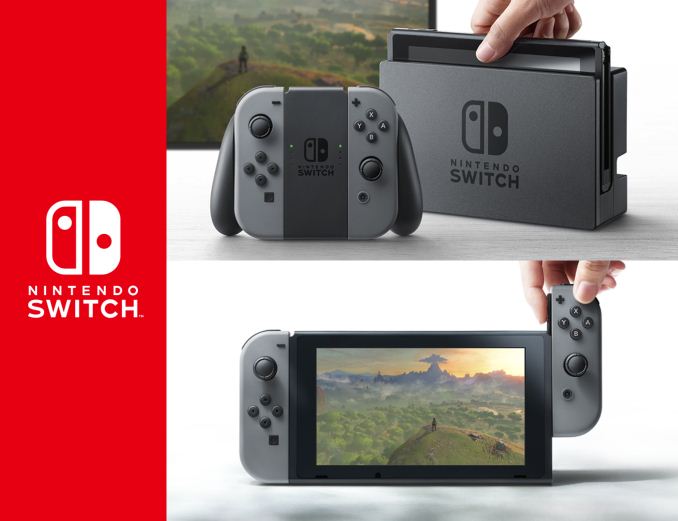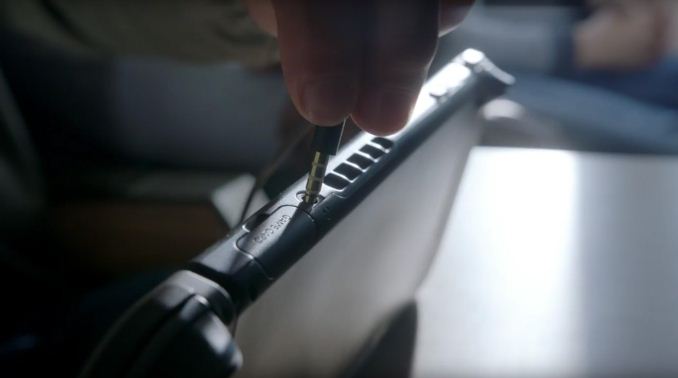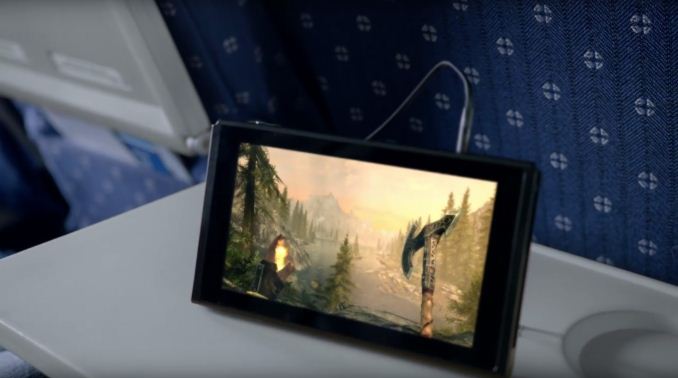Nintendo Announces Switch Portable Gaming Console - Powered by NVIDIA Tegra
by Ryan Smith on October 20, 2016 4:25 PM EST
Earlier today Nintendo took the wraps off of their next generation console, Switch. Formerly known by the codename NX, the Switch is the successor to both Nintendo’s portable DS and set top Wii console lines, utilizing a portable, tablet-like unit that can be docked to behave like a set top console. Today’s announcement, in the form of a 3 minute trailer, is meant to tease the console ahead of its full launch in March of 2017.
While I’ll skip the commentary on the console’s unusual design – dedicated gaming sites can offer better context – I wanted to dive into the hardware in the Switch. Given that this was a teaser, I was not expecting a reveal of any of the hardware specifications of the console, and indeed neither Nintendo’s teaser video nor their related press release made any mention of the underlying hardware. However shortly after the reveal went live, NVIDIA sent out an email to the press and posted a blog of their own. As it turns out, while today is still just a teaser, in some ways we’re already getting more information about the console than in any previous generation of Nintendo’s hardware.
In their blog post, NVIDIA confirmed that they would be providing the underlying SoC for the console. As this is still ultimately a teaser, NVIDIA’s own details are light, but their announcement confirms that it’s a custom version of their Tegra SoC. Curiously, no mention of the CPU core in that SoC is mentioned. However as it’s a Tegra, something ARM-based is the logical (if not only) choice. And on the GPU side, as you’d expect, they’re using a GPU based on one of NVIDIA’s existing GPU architectures, though the company isn’t specifying if it’s Pascal or Maxwell (I’d assume Pascal, but consoles are known for their long development cycles).
Otherwise, as far as specifications go that’s all we get for now. Though as NVIDIA is supplying a whole SoC there are obviously many more parts to the package that we’ll hopefully learn about in the near future. More CPU and GPU details are obviously the most interesting aspect – does the Switch SoC use Denver CPU cores? – but there’s also the matter of memory bandwidth, WiFi support, and the many other functional blocks that make up an SoC.
For NVIDIA, this is the first console hardware win for the company since the PlayStation 3, which launched in 2006. In the set top console market, AMD has since provided the GPU (and often, the CPU) for the most recent generation of consoles. Otherwise NVIDIA has never had a 3rd party portable console win, primarily because both Nintendo and Sony developed their respective SoCs internally for the 3DS and Vita.
In fact, given that Nintendo previously did much of their portable console development work internally, this is a notable shift for how the company operates. The 3DS was essentially a custom SoC combining multiple ARM11 (ARMv6) CPU cores with an OpenGL ES 1.1 generation GPU from the little-known Digital Media Professionals (DMP). So this is the first time Nintendo has contracted out their SoC needs to a third party in such a visible fashion. I’m actually a bit surprised that NVIDIA is even allowed to talk about their involvement at this point in time, given Nintendo’s historical focus on secrecy.
Though all of this also helps to underline just how big a jump in technology the Switch is from the 3DS. On the CPU side alone it’s reasonable to assume we’re looking at CPU design in the neighborhood of 4.x DMIPS/MHz, versus ARM11’s approximate 1.3 DIMPS/MHz rate, so IPC will have increased significantly, never mind an increase in frequency. Meanwhile on the GPU side, Nintendo is going from a GPU that didn’t even have a programmable GPU pipeline (i.e. shaders) to a fully modern GPU, essentially catching up on a decade of mobile GPU development in a single bound. Given that the console has to work as both the company’s portable and set top consoles, Nintendo has opted to use far more modern tech than their traditionally conservative designs.
Finally, without reading too much into a 5 paragraph announcement, there is one other interesting nugget of information in NVIDIA’s blog post that further shows just how deep the NVIDIA/Nintendo relationship is going here. Along with providing the SoC, NVIDIA also has a major stake in the development of the console’s API and middleware. While NVIDIA presumably isn’t developing the entire software stack, they make special note of the fact that they are providing a new “lightweight” API, NVN, for the console. NVIDIA is also providing middleware in the form of “a revamped physics engine, new libraries, advanced game tools and libraries” and “custom software for audio effects and rendering” which sounds a great deal like NVIDIA having brought over major parts of their GameWorks SDK, including the PhysX physics simulation libraries and VRWorks Audio library.
In any case, it will be interesting to see how this plays out over the next few months. The mobile world has changed significantly since the 3DS was launched in 2011, something that the Switch’s design makes obvious. Nintendo has gone in a very different direction than either their console rivals or the smartphone market that is always threatening to encroach on mobile consoles, and that’s reflected in both the unusual dual-mode console and the hardware inside of it.












109 Comments
View All Comments
Morawka - Friday, October 21, 2016 - link
Tegra will have fixed function blocks for 1080p and 4k Decode, just like Shield TV, no need to waste cycles on video.Yojimbo - Saturday, October 22, 2016 - link
My entire discussion was about rendering, not about decoding.Zingam - Friday, October 21, 2016 - link
Why are you talking about K1?X1 in Pixel C seems to have good battery life and good performance.
BTW. I have Pixel C and SHIELD TV. X1 seems to be 3x more powerful in SHIELD TV than in Pixel C.
IMO this console's true name is NINTENDO SHIELD.
barleyguy - Monday, October 24, 2016 - link
The spec sheet for Drive PX2 mentions the Tegra X2 by name. It's listed as "Four Cortex A57 Denver cores, 256 Pascal Graphics cores, 10 watt TDP". If you want to look it's in the announcement video for Drive PX2 on NVidia's website.barleyguy - Thursday, October 20, 2016 - link
"Notoriously bad battery life of the Tegra K1 Tablet"I own a Shield K1 tablet, and get a solid 12 hours or so out of it. I generally only have to plug it in every couple of days, though I plug in it every night next to my bed because it's my alarm clock.
Portable game consoles get far less battery life. The PSP 1000 was in the 5 hour range; the Vita is more in the 8 hour range. So if the Switch gets 12 hours like the Shield K1, that's competitive with the landscape of portable gaming consoles.
LukeTim - Friday, October 21, 2016 - link
The thing is the switch looks relatively chunky, so they should be able to fit a pretty decent sized battery in there.Also, I'm guessing that it won't have Android draining the battery with a hundred background processes.
On the flip side, it will be primarily a gaming device so the screen will be on and the GPU heavily utilized most of the time. I think it could realistically hit the 8 hours of the Vita, and maybe beat it slightly.
Jumangi - Friday, October 21, 2016 - link
your not getting 12 hours playing a 3D game. No portable device does that. A device like the Vita or even 3DS gets 3-5 hours when gaming.Wolfpup - Friday, October 21, 2016 - link
Plug it in any time you can anyway, as that's better on the battery. But anyway good info about the battery life :-)Morawka - Friday, October 21, 2016 - link
i plug my ipad in maybe once a month lol... the battery life is insane on ipad air 2 or newer.nikon133 - Tuesday, October 25, 2016 - link
But try using it. ;)